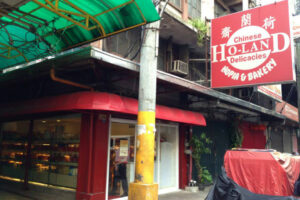THE GHOST month was not even in yet when a fire struck a famous street corner in Binondo, Carvajal corner Nueva (now Yuchengco), early on the first Friday of August, resulting in 11 deaths, mostly boarders of a dormitory in the upper floors of a building that also housed Ho-land Hopia and Chinese deli on the ground floor, which also wasn’t spared.
Among the dead were two coast guard trainees possibly about to wrap up studies in one of the merchant marine schools that sprout like mushrooms in that part of town, like the spaghetti electric wires and cables above the shops and residences; the wife of the building owner; as well as a cashier or other workers in nearby establishments, maybe including Ho-land, in the city to earn enough to occasionally send money home to the province.
Carvajal Street of course is no stranger to habitues of the noble and ever loyal city, surely part of walking tours of travel agency brochures, being just a stone’s throw away from Ongpin and its famed Binondo church fronting the plaza at Quintin Paredes and the first Filipino saint Lorenzo Ruiz doing battle with the ghost of ages.
“Anak ng hopia” was an expression unique to the old man, in fact it was only from him I heard it, a variation from the more popular, surely less savory, interjections of similar construction, and which you could also repeat after me — anak ng hopia — upon seeing the sprawling cornucopia of vegetables and fruits among other exotic foodstuff in the alley of Carvajal, named perhaps after the ancestors of showbiz columnist Dollywood and the tallest basketball player of his time that gave Jose Rizal University its last NCAA championship back when it was still a college on Shaw.
It was in that bountiful alley, so typical of the maze and labyrinths of the world’s oldest Chinatown, where we sometimes shopped on special occasions or merely as a foray or side trip when the office was in nearby Port Area, for the medicinal ulikba always sold in pairs, chicken so small and so black and so tasty shouldn’t be lonely, as well trays of freshly sorted langka, random memory chestnuts, anonas fruit rare as the holy grail, but always don’t forget to drop by Ho-land for the incomparable hopia otaosa or black mongo, the origs yellow mongo and baboy with their vintage paper wrappers long before the franchise experimented with other hopia flavors including ube and the best kept secret kondol or winter melon.
Such a trip would not be complete without a quick meal at the carinderia at the corner of Nueva and Ongpin, with its comfort food of kiampong and camto, ice cold soda on the side, to nourish oneself before the long walk to the LRT through scenic Escolta and the since shuttered Book Sale, or even hitch a ride on the Pasig river ferry, which now you see now you don’t.
Ho-land may have been best known for its hopia, and rightly so as these taste buds consider it head and shoulders above the competition, but it also had other products worthy of merienda or pasalubong, the typical pantawid gutom before the meal proper comes along or even never arrives, like the assorted empanadas with filling ranging from kuchay and mushrooms to chicken a la king and beef curry — all going at a bargain after 6 p.m. Also the phased-out chicken galantina that regaled many a family reunion spread, an assortment of machang, string color-coded whether pork, chicken, or a combination of both and/or with mushroom. Not to forget the gabi or radish cakes, slices of which are ready for frying.
Correct me if I’m wrong but wasn’t the original Mei-ling restaurant located in a Carvajal alley, a mere hole in the wall amid the overflowing merchandise, before it branched out to wealthier more accessible abodes in Megamall and Jupiter Street and other commercial spots? It was in such a nondescript place where we took the father-in-law for merienda of Schezwan noodles, after an adventure in nearby Sto. Cristo and Blumentritt in search of a crankshaft or similar major spare part for a passenger jeepney in Negros province. Comfort food gives me hope.
The hopia of the fatherland can’t be diminished by 11 deaths, though at times this recollection of so much food may leave a bad taste particularly for the bereaved — our condolences. But with ghost month well in I am thinking of taking a trip down to Pioneer Center to see whether the Ho-land deli branch has reopened — its metal gates were drawn down and padlocked the weekend after the fire. Just curious to see if the otaosa can rise from the ashes, as well it should, sesame seeds in the flaky pastry tasting like heaven, far and away from the hubbub of Binondo.
Glossary
hopia – a small bean-filled moon cake-like pastry
anak ng hopia – son of a hopia
ulikba – a breed of chicken with black feathers and meat
langka – jackfruit
anonas – sugar apples
mongo – mung beans
baboy – pork
ube – purple yam
carinderia – streetside restaurant
kiampong – glutinous rice casserole
camto – flank steak
merienda – afternoon snack
pasalubong – take-home gift
pantawid gutom – something to stave off hunger
empanadas – stuffed pastries
kuchay – Chinese chives
galantina – stuffed chicken
machang – stuffed glutinous rice packets
Juaniyo Arcellana is a semiretired/senior desk editor at BusinessWorld’s sister publication The Philippine Star. Thirty years ago he had a sports column called The Mopman in BusinessWorld.
